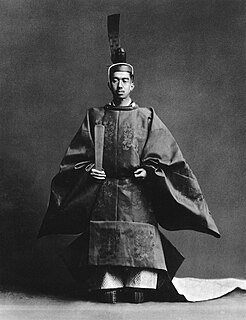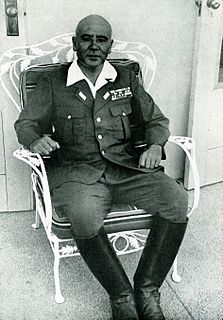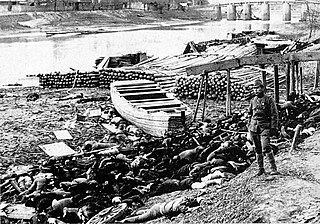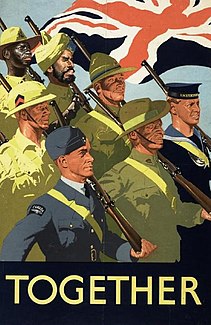
EmperorShōwa, better known in English by his personal name Hirohito (裕仁), was the 124th emperor of Japan, ruling over the Empire of Japan from 1926 until 1947, after which he was Emperor of the state of Japan until his death in 1989. He was succeeded by his fifth child and eldest son, Akihito. Hirohito and his wife, Empress Kōjun, had seven children, two sons and five daughters. By 1979, Hirohito was the only monarch in the world with the title "emperor". Hirohito was the longest-lived and longest-reigning historical Japanese emperor and one of the longest-reigning monarchs in the world.

The Imperial General Headquarters was part of the Supreme War Council and was established in 1893 to coordinate efforts between the Imperial Japanese Army and Imperial Japanese Navy during wartime. In terms of function, it was approximately equivalent to the United States Joint Chiefs of Staff and the British Chiefs of Staff Committee.

The Greater East Asia Co-Prosperity Sphere, or the GEACPS, was an imperialist concept which was developed in the Empire of Japan and propagated to Asian populations which were occupied by it from 1931 to 1945. It extended across the Asia-Pacific and promoted the cultural and economic unity of East Asians, Southeast Asians, South Asians and Oceanians. It also declared the intention to create a self-sufficient bloc of Asian nations which would be led by the Japanese and be free from the rule of Western powers. The idea was first announced on 1 August 1940 in a radio address delivered by Foreign Minister Yōsuke Matsuoka.

Yoshimichi Hara (原嘉道) was a Japanese statesman and the president of the Japanese privy council during World War II, from June 1940 until his death.

The Shōwa era refers to the period of Japanese history corresponding to the reign of Emperor Shōwa (Hirohito) from December 25, 1926 until his death on January 7, 1989. It was preceded by the Taishō period. The pre-1945 and post-war Shōwa periods are almost-completely different states: the pre-1945 Shōwa era (1926–1945) concerns the Empire of Japan, and post-1945 Shōwa era (1945–1989) is the State of Japan.
The Hull note, officially the Outline of Proposed Basis for Agreement Between the United States and Japan, was the final proposal delivered to the Empire of Japan by the United States of America before the attack on Pearl Harbor and the Japanese declaration of war. The note, delivered on November 26, 1941, is named for Secretary of State Cordell Hull. It was the diplomatic culmination of a series of events leading to the attack on Pearl Harbor. Notably, its text repeats previous American demands for Japan to withdraw from China and from French Indochina. No further American proposals were made before the attack on Pearl Harbor, as the US government had received intelligence that Japan was preparing an invasion of Thailand.

Masaharu Homma was a lieutenant general in the Imperial Japanese Army during World War II. Homma commanded the Japanese 14th Army, which invaded the Philippines and perpetrated the Bataan Death March. After the war, Homma was convicted of war crimes relating to the actions of troops under his direct command and executed by firing squad on April 3, 1946.
The Tanaka Memorial is an alleged Japanese strategic planning document from 1927 in which Prime Minister Baron Tanaka Giichi laid out for Emperor Hirohito a strategy to take over the world. The authenticity of the document was long accepted and it is still quoted in some Chinese textbooks, but historian John Dower states that "most scholars now agree that it was a masterful anti-Japanese hoax."

War crimes were committed by the Empire of Japan in many Asian-Pacific countries during the period of Japanese imperialism, primarily during the Second Sino-Japanese and Pacific Wars. These incidents have been described as an "Asian Holocaust", but this characterization of Japanese war crimes has been challenged by scholars on the basis of the unique features of the Holocaust. Some war crimes were committed by Japanese military personnel during the late 19th century, but most of them were committed during the first part of the Shōwa era, the name which was given to the reign of Emperor Hirohito.

The surrender of Imperial Japan was announced by Japanese Emperor Hirohito on August 15 and formally signed on September 2, 1945, bringing the hostilities of World War II to a close. By the end of July 1945, the Imperial Japanese Navy (IJN) was incapable of conducting major operations and an Allied invasion of Japan was imminent. Together with the British Empire and China, the United States called for the unconditional surrender of the Japanese armed forces in the Potsdam Declaration on July 26, 1945—the alternative being "prompt and utter destruction". While publicly stating their intent to fight on to the bitter end, Japan's leaders were privately making entreaties to the publicly neutral Soviet Union to mediate peace on terms more favorable to the Japanese. While maintaining a sufficient level of diplomatic engagement with the Japanese to give them the impression they might be willing to mediate, the Soviets were covertly preparing to attack Japanese forces in Manchuria and Korea in fulfillment of promises they had secretly made to the United States and the United Kingdom at the Tehran and Yalta Conferences.

Hakkō ichiu or Hakkō iu was a Japanese political slogan meaning the divine right of the Empire of Japan to "unify the eight corners of the world". This slogan formed the basis of the Japanese Empire's ideology. It was prominent from the Second Sino-Japanese War to World War II, popularized in a speech by Prime Minister Fumimaro Konoe on January 8, 1940.

The Japanese Empire occupied the Dutch East Indies during World War II from March 1942 until after the end of the war in September 1945. In Indonesian history, the period was one of the most critical.
Know Your Enemy: Japan is an American World War II propaganda film about the war in the Pacific directed by Frank Capra, with additional direction by experimental documentary filmmaker Joris Ivens. The film, which was commissioned by the U.S. War Department, sought to educate American soldiers about Japan, its people, society and history, and its totalitarian militaristic government. However, the film never realized its full purpose because its completion was delayed by disputes between Hollywood and Washington, and the abrupt end of the Pacific War soon after the film's release in August 1945. The film's first public screening was in 1977 as part of a PBS special.

Ikuhiko Hata is a Japanese historian. He earned his PhD at the University of Tokyo and has taught history at several universities. He is the author of a number of influential and well-received scholarly works, particularly on topics related to Japan's role in the Second Sino-Japanese War and World War II.

The Greater East Asia Conference was an international summit held in Tokyo from 5 to 6 November 1943, in which the Empire of Japan hosted leading politicians of various component members of the Greater East Asia Co-Prosperity Sphere. The event was also referred to as the Tokyo Conference.

When the United Kingdom declared war on Nazi Germany in September 1939 at the start of World War II, the UK controlled to varying degrees numerous crown colonies, protectorates and the Indian Empire. It also maintained unique political ties to four of the five independent Dominions—Australia, Canada, South Africa, and New Zealand—as co-members of the then "British Commonwealth". In 1939 the British Empire and the Commonwealth together comprised a global power, with direct or de facto political and economic control of 25% of the world's population, and of 30% of its land mass.
William Roger Louis CBE FBA, commonly known as Wm. Roger Louis or, informally, Roger Louis, is an American historian and a professor at the University of Texas at Austin. Louis is the editor-in-chief of The Oxford History of the British Empire, a former president of the American Historical Association (AHA), a former chairman of the U.S. Department of State's Historical Advisory Committee, and a founding director of the AHA's National History Center in Washington, D. C.

Hideki Tōjō was a Japanese politician, general of the Imperial Japanese Army (IJA) and war criminal who served as Prime Minister of Japan and President of the Imperial Rule Assistance Association for most of World War II. He assumed several more positions including Chief of Staff of the Imperial Army before ultimately being removed from office in July 1944. During his years in power, his leadership was marked by extreme state-perpetrated violence in the name of Japanese ultranationalism, in much of which he was personally involved.

The history of Japanese foreign relations deals with the international relations in terms of diplomacy, economics and political affairs from about 1850 to 2000. The kingdom was virtually isolated before the 1850s, with limited contacts through Dutch traders. The Meiji Restoration was a political revolution that installed a new leadership that was eager to borrow Western technology and organization. The government in Tokyo carefully monitored and controlled outside interactions. Japanese delegations to Europe brought back European standards which were widely imposed across the government and the economy. Trade flourished, as Japan rapidly industrialized.
Before Pearl Harbor the Japanese had already begun imperial expansion in Manchuria, (1931) Inner Mongolia, (1936) Jehol, (1933) China, (1937) and in other territories and islands during World War 1. The Empire of Japan entered World War II on 27th, September, 1940 by signing the Tripartite Pact with Germany and Italy, and the Japanese invasion of French Indochina, though it wasn't until the attack on Pearl Harbor on 7 December 1941 that the U.S. entered the conflict. Over the course of seven hours there were coordinated Japanese attacks on the U.S. -held Philippines, Guam and Wake Island, the Dutch Empire in the Dutch East Indies, Thailand and on the British Empire in Borneo, Malaya and Hong Kong. The strategic goals of the offensive were to cripple the U.S. Pacific fleet, capture oil fields in the Dutch East Indies, and maintain their sphere of influence of China, East Asia, and also Korea. It was also to expand the outer reaches of the Japanese Empire to create a formidable defensive perimeter around newly acquired territory.














